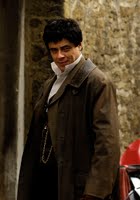 My review of Johnston's new film The Wolfman can be found here at BlogCritics.
My review of Johnston's new film The Wolfman can be found here at BlogCritics.While my review was negative (I couldn't call this a successful film, I'm afraid), it doesn't preclude me from digging into it a little more, and in doing so, discovering its minor triumphs. One of these was definitely its reimagining of the original Wolfman backstory, replicating a few key characters but wisely tightening the screws considerably.
After all, if you look at Lon Chaney Jr's 1941 film, the family history was pretty sparse. Lawrence Talbot was visiting his father, who acts the wise skeptic, and he's grappling with his brother's death, which isn't explained. Their mother is gone, also with no explanation, and Gwen Conliffe is just an engaged local girl who catches the creepy Lawrence's eye. This backdrop renders the main plot events - the bite, the transformation, the guilt, and the loss of humanity - mere workings of circumstance. The family and the estate were contexts, and nothing more.
Johnston's The Wolfman takes some serious liberties with this arrangement, overlaying a complex, intertwined heredity. First of all, Gwen isn't just a local vixen... she's Ben Talbot's widow, making her an honorary part of the family. Lawrence's family issues include tortured memories of his mother's death and a strained relationship with his father, but as we come to learn, they don't end there. The Talbot family and estate are afflicted with layers upon layers of misfortune, and it takes no time at all for us to get caught up in their web of dysfunction.
 Here's a failed tangent: it occurred to me, as I was reconsidering this movie, that the core emotional dynamic is made up of five players: Lawrence Talbot, his brother Ben Talbot, their father Sir John Talbot, their dead mother Solana, and Gwen Conliffe, the brothers' shared romantic interest. This seemed to relate, in some mystical way, to the five points of a pentagram... it's not mentioned in Johnston's version, but in the original Wolfman, the pentagram was the symbol for the werewolf, marking his next victim. I even tried mapping out the love, paternity, and marriage relationships between the five characters, to see if I could get a pentagram out of it. My semi-successful but ultimately irrelevant attempt accompanies this paragraph.
Here's a failed tangent: it occurred to me, as I was reconsidering this movie, that the core emotional dynamic is made up of five players: Lawrence Talbot, his brother Ben Talbot, their father Sir John Talbot, their dead mother Solana, and Gwen Conliffe, the brothers' shared romantic interest. This seemed to relate, in some mystical way, to the five points of a pentagram... it's not mentioned in Johnston's version, but in the original Wolfman, the pentagram was the symbol for the werewolf, marking his next victim. I even tried mapping out the love, paternity, and marriage relationships between the five characters, to see if I could get a pentagram out of it. My semi-successful but ultimately irrelevant attempt accompanies this paragraph.It's rather miraculous that this familial mess eventually distills into a sort of Hamlet retelling, the story of a son carrying out vengeance upon a father figure who has destroyed the household from within. Gwen may have initiated Lawrence's homecoming, but by the time he has been turned into a wolf and undergone "treatment" in an asylum, he's ready to set aside his low-key love affair with her in order to undertake his patricidal mission. She is an Ophelia, the scorned lover cast aside by a son with revenge in his eyes. Also note the theme of misconstrued madness which unites the two tales: two sons, each harboring a particular breed of quiet rage, each condemned as a madman while they search for a road to redemption.
And Lawrence has changed, too, between 1941 and The Year of Our Lord 2010. In 1941, he was the whipping boy of a cruel destiny, terrified of himself and adrift in the throes of his affliction. In Johnston's 2010 picture, though, Lawrence comes to terms with his uncontrollable rages and bestial nature... most fully, and most clearly, when he bristles to the assembly of doctors: "I ... WILL KILL ... ALL OF YOU!" It's a raw, dangerous, compelling moment, a surprising pinprick in a generally blunt film. It also resonates with a beautifully ambiguous note of self-awareness, hovering somewhere between a helpless warning and a beastly promise.
And Lawrence does kill. A lot. But as with all noble barbarians, he finally redirects his rage back into the darkness, toward the source of these troubles that he helps perpetrate. Lawrence's confrontation with his father is not only a departure from the 1941 text... it's actually a reversal, with the son turning a murderous hand upon the father that once killed him with a silver cane. In these 69 years, Lawrence has gained control of his body and his mind, and John has lost his compassion and control. In 1941, Lawrence was put down by his father, so in 2010, he returns and wreaks vengeance, not merely for the deaths of his mother and brother, but for his own murder, as well.
And so, even if Johnston failed in many of his key directorial duties, he should get credit for the romance and mystery he's squeezed into the margins of an old tale.
Grittiness: 8.5
This lacks the authenticity of a gritty cop, drug, and/or war movie, but it makes up for it in intimacy and intensity. It's a film at the intersection of horror and noir, packed tight with textures and fluids and reminders of the flimsy cohesion of our bodies. There's something especially degenerate about the old Victorian asylum to which Lawrence is consigned... The Wolfman takes place in a twisted, dirty world that may renew your appreciation for your sanitized 21st century.

No comments:
Post a Comment